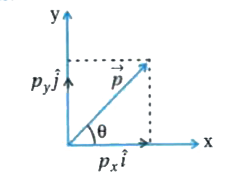InterviewSolution
Saved Bookmarks
| 1. |
An electric dipole has a fixed dipole moment vecp which makes angle 9 with respect to X-axis. When subjected to an electric field vecE_(1) = Ejhati ,it experience a torque vecT_(1) = tauveckWhen subjected to another electric field vecE_(2) = sqrt(3)E_(1)hatjit experiences a torque vecT_(2) - vecT_(1). The angle theta is: |
|
Answer» `60^(@)`  `vectau_(1) = VECP xx vecE` `=(p_(x)hati + p_(y)hatj) xx Ehati` `=-p_(y)Ehatk`………..(1) and `vectau_(2) =(p_(x)hati + p_(y)hatj) xx sqrt(3)Ehatj` `=sqrt(3)p_(x)Ehatk`………(2) but `vectau_(2) =-vectau_(1)` But `vectau_(2) =-vectau_(1)` `therefore sqrt(3)p_(x)Ehatk =-(-p_(y)Ehatk)` `therefore sqrt(3)=tan THETA` (From figure) `therefore theta = 60^(@)` |
|